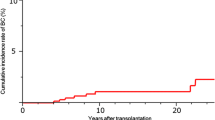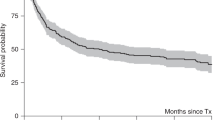Abstract
Purpose
Immunoediting is crucial in cancer development and progression. This study compared the characteristics and prognosis of post-transplant breast cancer (PTBC) patients receiving immunosuppressants and general breast cancer patients.
Methods
Data from the Asan Medical Center Breast Cancer (AMCBC), kidney transplantation, and liver transplantation databases recorded during 1989–2013 were retrospectively analyzed. Four controls of AMCBC cohort per one case of PTBC cohort were selected based on tumor size, lymph node metastasis, and age.
Results
After a median of 61 and 90.8 months after liver and kidney transplantation, respectively, 8 and 16 patients were diagnosed with breast cancer, respectively (p = 0.178). Mean age at breast cancer diagnosis was 51.9 (±8.7) and 45.2 (±4.5) years in liver and kidney transplantation patients, respectively. Age at diagnosis was significantly younger in kidney transplantation patients than in general breast cancer patients (45.2 ± 4.5 vs. 48.5 ± 10.1 years; p = 0.008). Cancer was detected via asymptomatic screening in 41.7% of the PTBC cohort but 30.6% of the control cohort (p = 0.241). In the PTBC cohort, 7 (29.2%) patients had stage 0 breast cancer compared with 1704 (9.7%) in the control cohort (p = 0.022); 22 (91.7%) patients had lymph node-negative cancer compared with 11,704 (66.8%) in the control cohort (p = 0.01). Estrogen receptor, progesterone receptor, and HER2 positivity did not differ between cohorts. Immunosuppressant use was not a poor prognostic factor for breast cancer patients.
Conclusions
Age at breast cancer diagnosis was younger in patients who received kidney transplants; the subtype and prognosis of breast cancer were comparable with that in the general cohort. Immunosuppressants do not adversely affect breast cancer prognosis.

Similar content being viewed by others
References
Birkeland SA, Lokkegaard H, Storm HH (2000) Cancer risk in patients on dialysis and after renal transplantation. Lancet 355(9218):1886–1887
Engels EA et al (2011) Spectrum of cancer risk among us solid organ transplant recipients. JAMA 306(17):1891–1901
Vajdic CM et al (2006) Cancer incidence before and after kidney transplantation. JAMA 296(23):2823–2831
Chapman JR, Webster AC, Wong G (2013) Cancer in the transplant recipient. Cold Spring Harb Perspect Med 3(7):a015677
Oruc MT et al (2004) De novo breast cancer in patients with liver transplantation: University of Pittsburgh’s experience and review of the literature. Liver Transplant 10(1):1–6
Navarro MD et al (2008) Cancer incidence and survival in kidney transplant patients. Transplant Proc 40(9):2936–2940
Végső G et al (2007) Malignancies after renal transplantation during 33 years at a single center. Pathol Oncol Res 13(1):63
Haberal AN et al (2007) Evaluation of posttransplantation malignancies compared with de novo tumors. Transplant Proc 39(4):1057–1062
Ali HR et al (2015) PD-L1 protein expression in breast cancer is rare, enriched in basal-like tumours and associated with infiltrating lymphocytes. Ann Oncol 26(7):1488–1493
Kwak H-Y et al (2013) Breast cancer after kidney transplantation: a single institution review. World J Surg Oncol 11(1):77
Lee S et al (2013) Prognostic impact of FOXP3 expression in triple-negative breast cancer. Acta Oncol 52(1):73–81
Ono M et al (2012) Tumor-infiltrating lymphocytes are correlated with response to neoadjuvant chemotherapy in triple-negative breast cancer. Breast Cancer Res Treat 132(3):793–805
Liu S et al (2012) CD8+ lymphocyte infiltration is an independent favorable prognostic indicator in basal-like breast cancer. Breast Cancer Res 14(2):R48
Rody A et al (2011) A clinically relevant gene signature in triple negative and basal-like breast cancer. Breast Cancer Res 13(5):R97
Pan K et al (2014) Clinical activity of adjuvant cytokine-induced killer cell immunotherapy in patients with post-mastectomy triple-negative breast cancer. Clin Cancer Res 20(11):3003–3011
Stagg J, Allard B (2013) Immunotherapeutic approaches in triple-negative breast cancer: latest research and clinical prospects. Ther Adv Med Oncol 5(3):169–181
Song G-W, Moon DP et al (2017) Dual-graft adult living donor liver transplantation: an innovative surgical procedure for live liver donor pool expansion. Ann Surg 266(1):10–18
Cheung CY et al (2012) Malignancies after kidney transplantation: Hong Kong renal registry. Am J Transplant 12(11):3039–3046
Kim JH et al (2014) Post-transplant malignancy: a burdensome complication in renal allograft recipients in Korea. Clin Transplant 28(4):434–442
Kato T et al (2016) The benefits of cancer screening in kidney transplant recipients: a single-center experience. Cancer Med 5(2):153–158
Barnett CM (2012) Everolimus: targeted therapy on the horizon for the treatment of breast cancer. Pharmacotherapy 32(4):383–396
Akker JMH-vd et al (2013) Two-year randomized controlled prospective trial converting treatment of stable renal transplant recipients with cutaneous invasive squamous cell carcinomas to sirolimus. J Clin Oncol 31(10):1317–1323
Caroti L et al (2012) Conversion from calcineurin inhibitors to everolimus with low-dose cyclosporine in renal transplant recipients with squamous cell carcinoma of the skin. Transplant Proc 44(7):1926–1927
Salgo R et al (2010) Switch to a sirolimus-based immunosuppression in long-term renal transplant recipients: reduced rate of (pre-) malignancies and nonmelanoma skin cancer in a prospective, randomized, assessor-blinded, controlled clinical trial. Am J Transplant 10(6):1385–1393
Author information
Authors and Affiliations
Corresponding author
Ethics declarations
Conflicts of interest
There are no conflict of interest.
Human and animal rights
This article does not contain any studies with human participants performed by any of the authors.
Rights and permissions
About this article
Cite this article
Jeong, IJ., Lee, SG., Kim, Y.H. et al. Characteristics and prognosis of breast cancer after liver or kidney transplantation. Breast Cancer Res Treat 167, 101–106 (2018). https://doi.org/10.1007/s10549-017-4504-1
Received:
Accepted:
Published:
Issue Date:
DOI: https://doi.org/10.1007/s10549-017-4504-1




